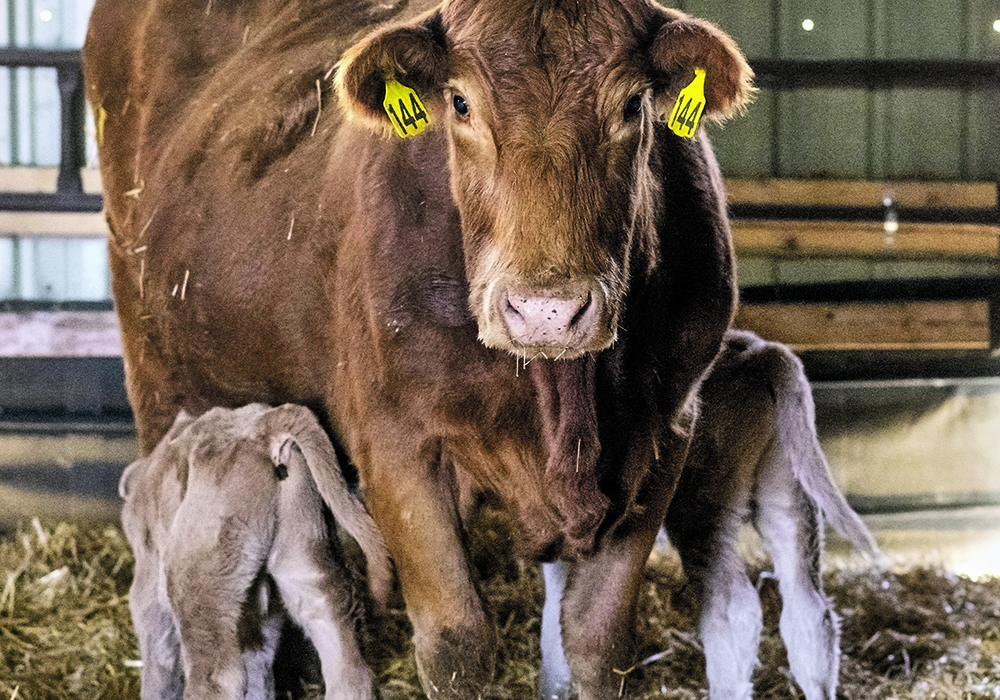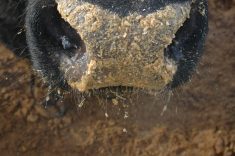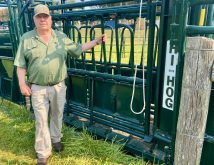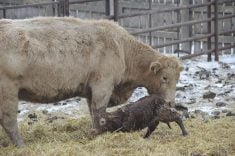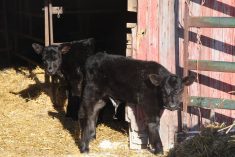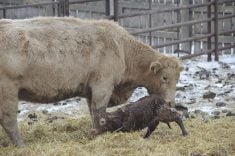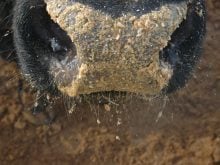With calving underway or close by for many producers, veterinarians and the Beef Cattle Research Council offer pointers to minimize challenges and increase calf survival rate.
The day a calf is born is the highest risk day of its life, so producers need tools to keep calves alive. Successful management during the calving season can result in healthier and more productive calves.
Keep them upright
Calves should not be held or hung upside down if they need help breathing.
If a newborn is unable to breath on its own, it’s a common mistake to hang it upside down with the idea of helping it drain aspirated fluid from its lungs. Instead, this makes it more difficult for the calf to start breathing.
“Fluid does come out of their mouth, but it’s mostly coming out of their stomach,” said Tiffany Pomarenski, a veterinarian with a practice based in Ogema, Sask.
“What is actually happening is we’re impeding their ability to breathe. If you hang a calf upside down, all their abdominal organs are pushing down on their chest, which makes it harder for them to actually breathe, to expand that chest.”
If resuscitation is required, the calf should be put in the recovery position with both front legs tucked underneath the chest or out in front and back legs on each side of the body, pulled toward the head.
The chest-sitting position expands the lungs with the least amount of pressure and aids breathing.
Sprinkling drops of cold water in the ear while in this position causes the calf to shake its head, helping open the airway. Avoid excess water, which can cause an ear infection.
“I always say, get them mad until they want to live,” said Pomarenski.
Other effective irritants include poking a piece of straw in the nostril at the nasal septum, the tissue separating the two nostrils on the inside.
“There’s a pressure point in their nerve point, just like when we look up at the sun and sneeze. That’s kind of the same thing that happens when you poke there,” she said.
Consider giving a pain control product, such as meloxicam, to calves after a difficult birth.
“It is painful for them to come out of the birth canal, especially if you have to use the calf jack, a head or foot is back, or for a long birth. It really helps them to get up and start to suck right away,” she said.
Watch the colostrum
Take action if the calf hasn’t received colostrum two to four hours after birth.
“We call colostrum liquid gold. It’s so important for that neonatal calf,” said Jennifer Pearson from the Faculty of Veterinary Medicine at the University of Alberta during a Beef Cattle Research Council webinar.
Colostrum provides necessary antibodies to a calf that has no immune system at birth. It contains essential nutrients that provide the calf with energy and disease immunity.
It’s important that producers have a banked supply of colostrum on hand. Calves are able to absorb antibodies up to 24 hours after birth.
Three products are commercially available in the absence of natural colostrum from the same herd. Milk replacer will typically be used with bottle-fed calves that need supplemented nutrition.
Colostrum replacer should be given to calves that don’t get up and nurse within the first few hours.
“When you’re looking at these products, if you want a true colostrum replacer product, you should look on the bag and look for products that have at least 100 grams per package,” said Pearson.
Tube feeding
Calves need at least two litres when tube feeding colostrum.
“An easy way to remember how much colostrum to give a newborn calf is to aim for two litres (warmed to 38 C) by two hours. Then, if the calf still hasn’t gotten up and nursed from its dam, repeat another two litres within 12 hours,” said Pearson.
Esophagus tube feeding will place fluids in the rumen instead of the abomasum, as it normally would when a calf sucks. The rumen needs to slowly overfill and flow into the abomasum before the colostrum is absorbed in the calf’s small intestine.
“Tube feed if you’re not quite sure if the calf has sucked yet, it has no vigour, or if the cow has a bad udder,” said Pomarenski.
Separate tube feeders
Have separate tube feeders for sick and healthy calves.
Maintaining two designated stomach feeders helps prevent spread of diseases and pathogens.
The McGrath feeder is most commonly used and considered the most practical when handling calves alone. The feeder allows fluids to be poured into the top of the bag and hung from a height to flow slowly via gravity.
The calf can be tube-fed in a sitting position or lying down, but never tip the calf’s nose up while tubing. The head should be in a neutral position above the level of its stomach.
Never force the tube down and once placed, it should be easily palpated next to the trachea.
“Remember the two-tube rule. You should be able to feel the trachea and the stomach tube,” according to BCRC.
It could take more than three minutes for liquids to slowly fill the stomach and minimize regurgitation.
The tube should be slowly pulled out to prevent aspiration into the lungs, and then disinfected, drained and dried.
Look for dehydration
Recognizing the symptoms of disease and dehydration in young calves can make a substantial impact on a producer’s bottom line.
“Many of our calves that are experiencing neonatal calf diarrhea or scours, they don’t actually die from the viruses or bacteria protozoa that cause scours. They die from the resulting dehydration, electrolyte imbalances, and in some cases acidosis,” said Elizabeth Homerosky, veterinarian at Agri-Health Services in Alberta, during a BCRC webinar.
There are several behavioural cues to look for such as drooping ears, sunken eyes and lethargy.
The skin tent test is also a quick way to evaluate dehydration.
“Pinch the skin right over the neck area. Make a tent and then count the number of seconds it takes for that skin to return to normal,” said Homerosky.

If the skin flattens in less than two seconds, hydration is normal. If it takes two to four seconds to flatten, the calf is six to eight percent mildly dehydrated.
“They may still be up ambulating around in nursing, but they’re not quite keeping up with their fluid requirements.
“Providing oral fluids with electrolytes can help a calf recover.”
If the skin tent takes four to six seconds to flatten, the calf is eight to 10 percent dehydrated but if it takes more than six seconds, the calf is 10 to 12 percent dehydrated and likely comatose.
“At that point, it’s important to involve your veterinarian. We often see dehydration, electrolyte disturbances and acidosis all happening simultaneously,” said Homerosky.
Clean bedding
Lower disease transmission with clean and dry bedding.
Exposure to harmful pathogens can be reduced by providing cows and calves with a clean, dry place with adequate space.
“We hope for a clean, dry spring, but we’re also hoping for a nice wet spring. So pick your poison, I guess,” said Pomarenski.
Pasture management during calving can reduce disease in calves. Cows can shed pathogens that can cause disease in calves with fragile immune systems. Avoid calving on the same pasture where cows have overwintered.
Move pairs into a nursing pasture within the first 24 hours of birth. Try to maintain nursery pastures with similar aged calves instead of rotating calves through pastures, experts advise.
Have a separate bedding area for young calves during the winter, such as calf huts that do not allow cows to enter.
Compared to spring calving with clean, open pastures, winter calving produces more disease pressure. Watch when moving around feeders because calves will often bed down in hay to find warmth during storms and cold weather.
“The cows will come and step on them, so you’ll find broken legs and dead calves,” Pomarenski said.
Maintain accurate records
An understanding of the herd depends on tracking cow behaviour and other maternal qualities.
“Everybody says they’re going to remember come springtime or come fall time, but nobody does. So write it down. Put it in your calendar on your phone,” said Pomarenski.
Keeping track of calving ease, calf loss and cow temperament at calving will help producers make better management decisions. It will also help with culling decisions.


